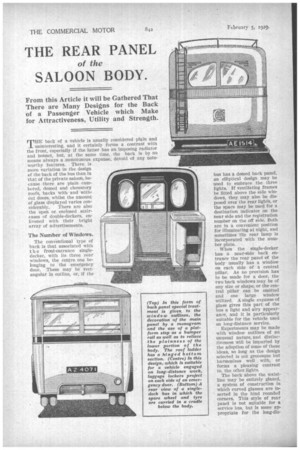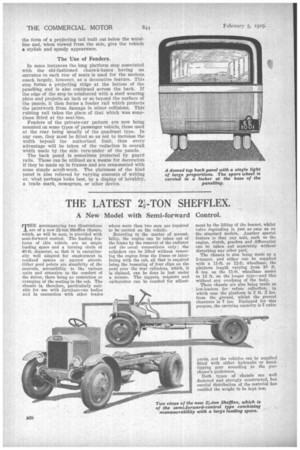THE REAR PANEL
Page 20

Page 21

Page 22

If you've noticed an error in this article please click here to report it so we can fix it.
of the
SALOON BODY.
From this Article it will be Gathered That There are Many Designs for the Back of a Passenger Vehicle which Make for Attractiveness, Utility and Strength.
THE back of a vehicle is usually considered plain and uninteresting, and it certainly forms a contrast with the front, especially if the latter has an imposing radiator and bonnet, but, at the same time the back is by no means always a .monotonous expanse, devoid of any noteworthy features. There is more variation in the design of the back of the bus than in that of the private saloon, because there are plain cambered, domed and clerestory roofs, backs with and without doors, whilst the amount of glass displayed varies con
siderably. There are also the Open or enclosed staircases of double-deckers. enlivened with their bright array of advertisements.
The Number of Windows.
The conventional type Of back is that associated with the front-entrance singledecker, with its three 'rear windows, the centre one belonging to the emergency door. These may be rectangular in outline, or, if the
bus has a domed back panel, an elliptical design may be used to embrace the three lights. If ventilating frames be fitted above the side windows, they may also be disposed over the rear lights, or the space may be used for a destination indicator on the near side and the registration number on the off side. Both are in a convenient position for illuminating at night, and sometithes the rear lamp is incorporated with the number plate.
When the single-decker has a near-side back entrance the rear panel of the body usually has a window on each side of a central pillar. As no provision has to be made for a door, the two back windows may be of any size or shape, or the central pillar can be omitted and one large window utilized. A single expanse of glass gives this part of the bus a light and airy appearance, and it is particularly suitable for the vehicle used on long-distance service.
Experiments may be made with window outlines of an unusual nature, and distinctiveness will be imparted by the adoption of some of these ideas, so long as the design selected is not grotesque but harmonizes well with, or forms a pleasing contrast to, the other lights.
The back above the waistline may be entirely glazed, a system of construction in which curved glasses are inserted in the hind rounded corners. This style of rear panel is not suitable for a service bus, but is more appropriate for the long-dis tance vehicle, especially if it has a rear observation compartment with the seats facing to dile rear or towards the central gangway. If the seats face to the rear, the bottom line of the windows may be a few inches lower than it is at the sides, thereby affording a better outlook.
Extended Panels.
The extension of the main panels to the step level has made a great difference to the appearance of the sides of the bus, but the effect produced at the back is even more,a)ronounced, because the depth of panelling is then in proportion to the width and not to the length of the body. As the waist-line is already comparatively high, it will not be advisable to increase its height, as it travels around to the back, therefore the same level of elbow moulding or belt panelling is usually maintained throughout.
The carrying of the spare wheel at the rear helps to -form some relief to this large area of panelling.
The wheel may be held in position-vertically or be carried on a cradle between the longitudinal chassis members just aft of the rear axle and the panel cut away for its reception, or a hinged flap may be provided so that the wheel is concealed.
. Means for accommodating the spare wheel are now a familiar feature of the public-service vehicle, and in view of the new scale of taxation, which favours the use of pneumatic tyres and which will result in new buses mounted on solid tyres soon becoming a rarity, further attention will undoubtedly he given to this problem of housing the spare wheel and tyre.
The "Three-quarter" Back.
The rear platform, which is open at the back and sides above the waist level, is no longer built, but the type of bus with a back panel which does not enclose the steps is still in favour. The roof, however, is of the same shape as that employed in conjunction with a fully vestibuled back entrance and covers the open pear-hind corner. With this design of back the bottom step is accessible from the rear, as well as from the side, consequently it is, perhaps, more suitable for use in a busy district, although it is a pattern of entrance which tempts the passenger to mount or dismount while the vehicle is in motion. It is a variation which is only adopted for the service bus and often has no door at the top of the steps.
From the constructional point of view the "threequarter" back has the advantage that the entrance may be placed right at the end of the body, whereas when the near-hind corner is rounded and panelled the radius of this corner. takes up valuable space, and if it be too small for a seat it has little value, except for the disposal of a ticket locker. the form of a projecting tail built out below the waistline and, when viewed from the side, give the vehicle a stylish and speedy appearance.
The Use of Fenders.
In some instances the long platform step associated with the old-fashioned chars-a-bancs having an entrance to each row of seats is used for the modern coach largely, however, as a decorative feature. This step forms a projecting ridge at the bottom of the panelling and is also continued across the back. If the edge of the step be reinforced with a steel wearing plate and projects an inch or so beyond the surface of the panels, it then forms a fender rail which protects the paintwork from damage in minor collisions. This rubbing rail takes the place of that which was sometimes fitted at the seat-line.
Fenders of the private-car pattern are now being mounted on some types of passenger vehicle, those used at the rear being usually of the quadrant type. In any case, they must be fitted so as not to increase the width beyond the authorized limit, thus every advantage will be taken of the reduction in overall width made by the side turn-under of the panels.
The back panel is sometimes protected by guard rails. These can be utilized as a means for decoration if they be made up in frames and are ornamented with some simple scroll-work. The plainness of the hind panel is also relieved by varying amounts of writing or, what perhaps looks best, by a display of heraldry, a trade mark, monogram, or other device.


































